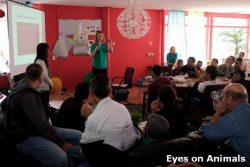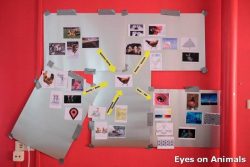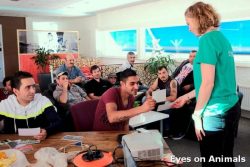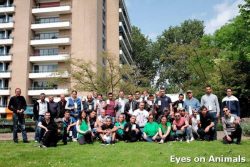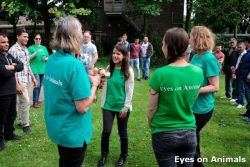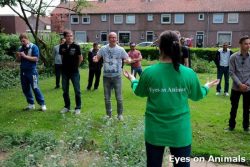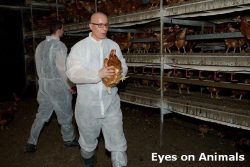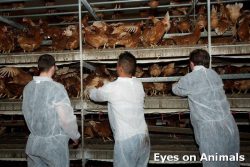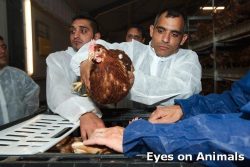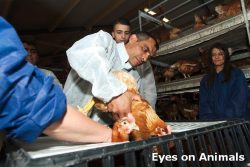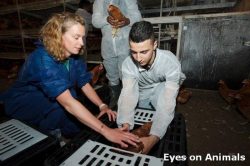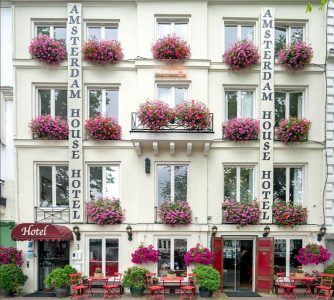This past Saturday we held, for the first time, a welfare-workshop for chicken-catchers. We gave this training course to the Netherlands´ largest chicken-catching company, called Gemril in Arnhem. Gemril specializes in the catching and loading of “spent” laying-hens. They are hired by egg farmers to come and empty the barns when the hens are no longer laying enough eggs and the farmer wants to send his birds to slaughter.
Chicken-catchers often have difficult working conditions. The average catcher is supposed to catch between 150 and 250 hens per hour in dark and dusty conditions. The welfare of the birds during this process is often badly compromised. The hens are grabbed 3-5 at a time, by one leg, and left hanging upside down screaming while the catcher tries to grab another bunch with his other hand. The hens are then loaded headfirst and often roughly through the top-openings of transport crates. The pressure on the chicken-catchers to work fast and keep the costs low for the farmer is high, because the price of eggs nowadays is so low.
The training course was made up of a 3-hour theoretical part in a classroom and a 2-hour practical part at a Demeter laying-hen farm. During the theoretical part we discussed the anatomy, physiology and behaviour of laying hens, and then took that information and applied it on how one could reduce some of the suffering and stress of the birds during conventional catching. For example, we made the catchers aware of the sensitive hearing of hens to remind them to keep their own voice down, that they should move smoothly not abruptly, to wear dark clothes and use blue light to keep the birds from being on alert, to not shine lights from the fork lift into the barn, to never grab more than 2 birds at a time by their legs and always hold both legs, not just one, and support the breast. To also never leave them hanging upside down while grabbing more birds with the other hand but instead immediately placing the first group into the crate to allow them to stand again. And to check for wings and heads poking out before stacking the crates.
But we also taught the chicken-catchers an alternative manner of catching and loading poultry, called the ” EonA Dutch method”. In the EonA Dutch method, birds are not caught by their legs or suspended upside down but rather caught upright, maximum 1-2 at a time and placed upright gently, 1-2 at a time, into the crate. (The normal way people would want to catch hens if they were not under economic pressure). Scientific studies have shown that birds produce 3 times more corticosterone when grabbed by the their legs and suspended upside down than during gentle, upright catching. We practiced this much more humane method together during the practical part of the training at a Demeter egg farm.
We would like to thank the Dierenbescherming for offering to cover a part of the costs of this course and for showing support for this idea. Our aim, and the Dierenbescherming share this vision, is that the more gentle method of catching and loading birds will be put into the criteria for organically labelled eggs in the near future. Considering the Dierenbescherming runs the 3-star Beter Leven program in the Netherlands for eggs, we feel confident that it will become a reality soon here and thus are happy to get the catchers ready.
We would like to thank Gemril company and the Demeter farmer who took this training seriously and were enthusaistic and good to work with.
To learn more about the difference between the commercial and “alternative EonA Dutch method” please watch our short video https://youtu.be/TTsqqzVJHbw. The EonA Dutch method takes 3 times as long, so in order for this method to be effective the farmer would need to hire 3-times more catchers to do the job in the same amount of time. This will result in slightly higher costs, but several organic, free-range farmers have told us that the difference in cost is not very significant when one can spread it over the 1.5 years of receiving an egg almost every day from each hen.
